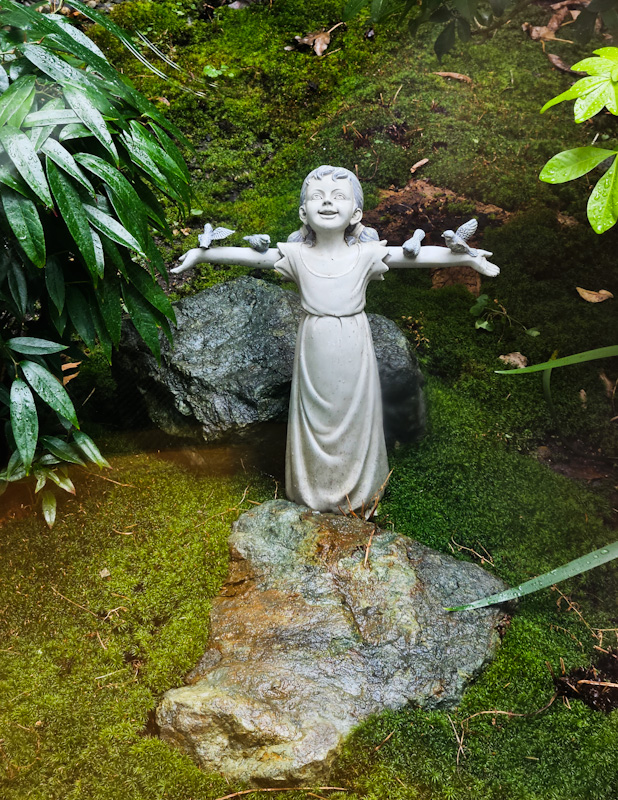
Photo and Commentary ©2024 by Shelley Schurch
Sunday, January 28, 2024
The second thing I thought when I saw this statue was to wonder what it would feel like to have little birds perched on your arms – would it tickle? Or have a firmer feel than that?
I spied this statue as we were walking down the hall of our clinic. This little girl is in a very small garden spot just off the downstairs hall, close to the side exit. I don’t remember seeing her before.
The first thing I thought when I saw her was how happy she looked. She is either a bird lover, or joyful about something else and the birds are taking advantage of her outstretched arms.
I saw this statue eight days ago, and have looked at the photo several times since. It makes me smile to see her smile, and to think how many thoughts have come to mind because I’ve given her more than a cursory glance.
I understand that taking conversational detours, where conversation flows easily from one topic to another, can be called “birdwalking.” Here’s some of the “thought birdwalking” I’ve done, after my first two thoughts about this statue:
I thought about her arms being outstretched in cruciform, the shape of a cross. I discovered that Celtic saints, among others, often prayed like that. I read several accounts of Celtic Saint Kevin (born 498 – supposedly the first person in history to be named Kevin) kneeling in prayer one day with his arms outstretched as usual. His hut was so small that one arm had to be thrust outside through the window. A bird alighted and laid an egg in his hand, and he kept his arm outstretched until the egg hatched. (Keep in mind that I did not hear this story firsthand so cannot vouch for its veracity!)
That led me to contemplate the variety of prayer postures I’ve read about in the Bible. Since I cannot kneel without pain, due to tripping and then skidding on my knees across our church platform one memorable morning, I’m grateful to know that God can and will hear us even if we’re not kneeling.
My thoughts then birdwalked back to the outstretched arm – not the little girl’s or Saint Kevin’s, but God’s. Our Bible study group has completed our trek through the book of Genesis, and has marched right on into the book of Exodus. So far we’ve followed Moses from his basket floating in the Nile River, to his adoption by Pharaoh’s daughter, to fleeing Egypt after taking justice into his own hands and killing an Egyptian who was beating a Hebrew, to his 40 years of tending sheep in the desert – to one apparently ordinary day when he encountered the bush that was burning but not burning up and was told to take off his sandals because he was standing on holy ground.
He answered God’s call to leadership in a cautious manner, often characterized as “Here I am – send someone else!” God, although not pleased, accommodated his hesitancy by bringing his big brother Aaron alongside him to act as spokesman. They obey God and approach Pharaoh with God’s message. Pharaoh is not impressed and responds with haughty cruelty, making the Hebrew slaves’ work much harder.
Moses is distraught and pulls no punches as he speaks to God:
“Lord, why have You brought trouble on this people? Why is it You have sent me? For since I came to Pharaoh to speak in Your name, he has done evil to this people; neither have You delivered Your people at all.” (Exodus 5:22, 23 NKJV)
And now we arrive at one of my favorite passages in Exodus; we hear God’s response. As recorded in 8 vigorous verses, God says “I” 18 times, as He describes what He is about to do to Pharaoh and the Egyptians, and for Moses and the children of Israel. The core of his message is:
Therefore say to the children of Israel: “I am the LORD; I will bring you out from under the burdens of the Egyptians, I will rescue you from their bondage, and I will redeem you with an outstretched arm and with great judgments. I will take you as My people, and I will be your God. Then you shall know that I am the LORD your God who brings you out from under the burdens of the Egyptians.” (Exodus 6:6,7 NKJV)
This is the first of 16 times that the phrase “outstretched arm” is used in the Old Testament, almost always to remind the Israelites how God brought them out of slavery to freedom with His “mighty hand and outstretched arm.” Twice it describes how God created the earth.
Then we birdwalk into the New Testament, and the outstretched arms are Jesus’. Outstretched in healing, outstretched in calming storms, outstretched in blessing. Until they are outstretched on the cross for our sin-healing.
One more thing I noticed about the statue of the little girl: she is looking up. As we step out into this brand-new week, we can do the same, keeping our eyes on Jesus. See Him on the cross, see Him in heaven, waiting to welcome us Home. With outstretched arms.
